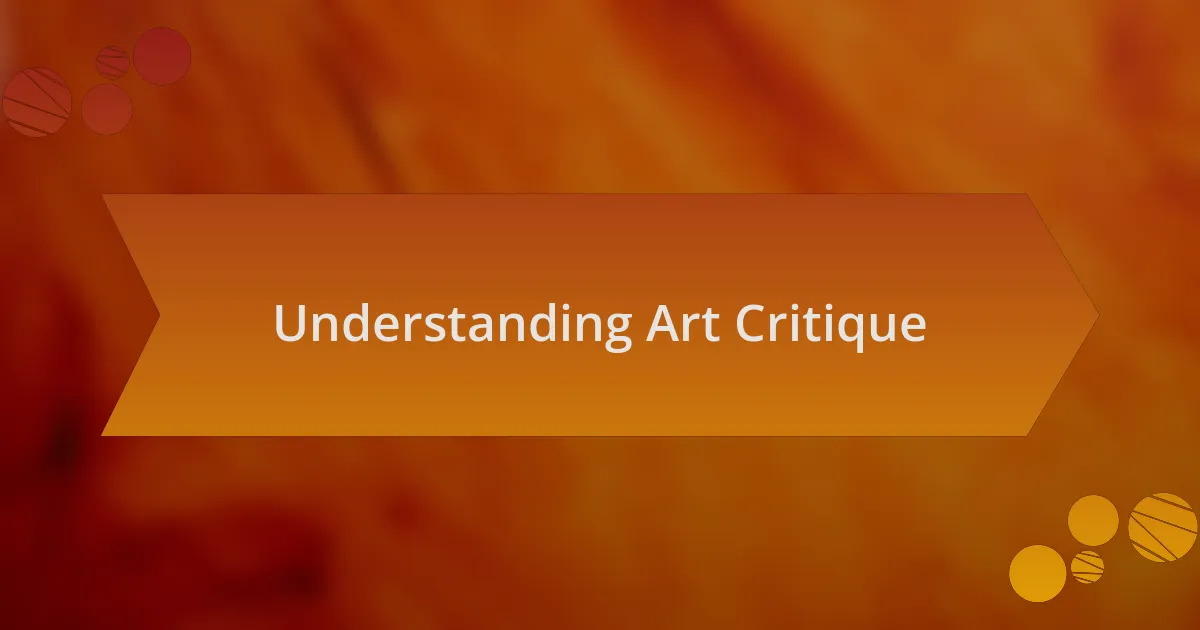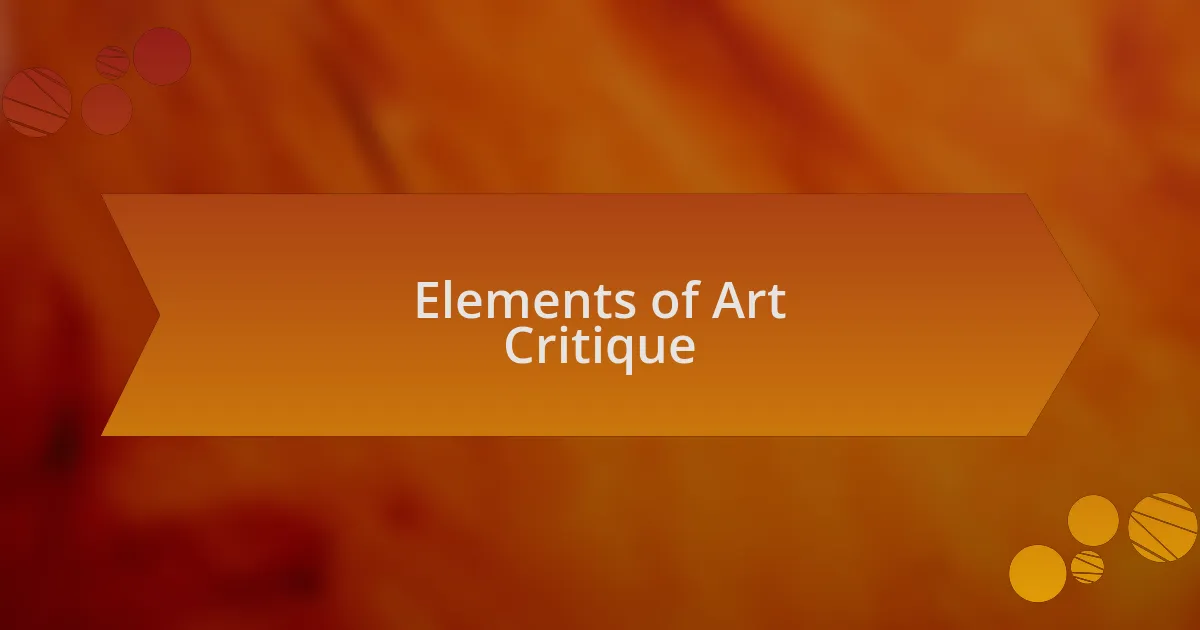Key takeaways:
- Art critique is an exploration of emotions and narratives that deepens understanding and appreciation of artwork.
- Constructive feedback plays a vital role in an artist’s growth and fosters connections between viewers and the artwork.
- Key elements of critique include composition, color, and texture, which can significantly influence emotional responses and interpretations.
- Personal experiences and vulnerability enhance the critique process, revealing layers of meaning within art.

Understanding Art Critique
Understanding art critique means engaging in a thoughtful dialogue about the pieces we experience. I remember a time when I stood before a striking abstract painting, feeling a swirl of emotions but struggling to articulate why it resonated with me. Isn’t it fascinating how art can evoke such profound feelings, yet expressing those sentiments can be challenging?
I have learned that art critique isn’t about judgment; it’s about exploration. Each artwork has its own story, and the critique process allows us to delve deeper into that narrative. I often ask myself, what does this piece say about the artist’s intentions, and how does it reflect our shared experiences? These questions guide me to a richer understanding.
There’s a beauty in sharing different perspectives during critiques. I recall a lively discussion among friends about a sculpture that left me confused. Their insights opened my eyes to interpretations I hadn’t considered, showcasing how diverse viewpoints can enhance our appreciation of art. Isn’t it incredible how collaboration can deepen our understanding?

Importance of Art Critique
Art critique plays a crucial role in nurturing both the artist and the audience. When I participated in a local exhibition, I witnessed firsthand how constructive feedback empowered the artist to refine their work. It became clear to me that critique is not an act of tearing down; rather, it serves as a catalyst for growth and exploration, illuminating areas for improvement while celebrating successes.
Moreover, engaging in art critique fosters a deeper connection between viewers and the artwork. I recall standing in front of a contemporary installation, feeling a disconnect. However, after hearing a fellow viewer articulate their thoughts about the piece, I found new layers of meaning that changed my perspective entirely. Have you ever encountered an artwork that felt empty until someone else’s interpretation suddenly made it resonate? This experience demonstrated how critique can transform initial confusion into appreciation.
In addition, art critique encourages a dialogue about cultural relevance and societal issues. I remember discussing a thought-provoking piece that tackled themes of identity and representation. As we unpacked the layers of context, I realized how crucial it is to evaluate art through the lens of its societal impact. It makes me wonder: how often do we consider the broader narratives woven into the art we encounter? Engaging in critique allows us to reflect on these important conversations and connect art with our shared human experiences.

Elements of Art Critique
When I approach art critique, I focus on several key elements that provide structure and depth to my analysis. First, I consider the composition, which includes how the artist arranges the elements within the artwork. I recall visiting a gallery where a particularly striking piece utilized symmetry to evoke a sense of calm, drawing me in. Isn’t it fascinating how something as simple as balance can significantly impact our emotional response?
Color is another essential element I pay close attention to. Different hues can evoke distinct emotions and convey various messages. I once dissected a painting where the artist used bold reds and deep blacks to explore themes of passion and conflict. Seeing the work through that lens opened up an exhilarating dialogue about emotional complexities in art. Can you think of a piece where color changed your understanding of the artist’s intent?
Additionally, texture can dramatically influence our sensory experience. During one critique session, I examined a mixed-media piece that combined smooth surfaces with rough, tangible elements. This contrast created a dialogue between comfort and discomfort, inviting viewers to feel rather than just observe. Have you ever touched an artwork and found that it amplified your connection to it? Recognizing these elements in art not only enriches our understanding but also deepens our appreciation for the artist’s craft.

Techniques for Effective Critique
When critiquing art, I find that employing a framework can significantly enhance the process. One technique I use is the “show, don’t tell” approach. Instead of merely stating what I see, I describe my emotional reaction first. For instance, I once encountered an abstract piece that made me feel unsettled. By articulating that initial response, I was able to unpack layers of meaning that I might have otherwise overlooked. How often do we stop to explore our immediate feelings toward an artwork?
Another effective critique technique involves asking open-ended questions. I often pose inquiries like, “What story is the artist trying to tell?” or “How does this work reflect their personal journey?” This practice encourages a dialogue that invites deeper exploration of the artwork. I remember discussing a sculpture that appeared fragmented. By questioning its intended narrative, I discovered connections to themes of loss and resilience that resonated with many in the group. Have you thought about how your questions could change the direction of a conversation on art?
I also believe in the power of comparison during critique. By contrasting different works or styles, I’m able to highlight unique qualities. For example, while evaluating two portraits—one classical and one contemporary—I drew parallels between their representations of identity. This comparison opened a richer discussion about how the context of an era influences artistic choices. Have you experienced the eye-opening effect of seeing art side by side?

Personal Approach to Art Critique
In approaching art critique, I find that it helps to focus on personal connection. For example, I once stood before a vibrant landscape painting that instantly transported me to a childhood memory of playing in my grandmother’s garden. By sharing that personal story, I could articulate how the colors sparked joy and nostalgia in me, revealing layers within the artwork that went beyond the canvas. Have you ever found yourself reminiscing when viewing a piece of art?
I also pay attention to the techniques and materials used by the artist, as they often convey deeper meanings. I recall analyzing a mixed media piece that incorporated shredded letters and fabric. Each texture told a story of intimacy and separation, making me think about the fragility of communication. How do the materials a painter chooses alter your perception of their message?
Another key aspect of my critique process involves embracing vulnerability. I remember critiquing a video installation that challenged viewers to confront discomfort. I found myself questioning my reactions, considering how my own insecurities shaped my interpretation. Isn’t it fascinating how our personal experiences can influence the meaning we derive from art? These moments of reflection enrich the critique, making it a genuine exploration of both the artwork and ourselves.

Lessons Learned from Critique
One of the most valuable lessons I’ve learned from critique is the importance of perspective. I recall visiting an art exhibition where a seemingly simple abstract piece sparked an intense debate among viewers. Each interpretation unveiled a unique lens—some saw chaos while others found harmony. It made me realize how a single work of art can resonate differently based on our individual experiences. Have you ever shared your thoughts about an artwork only to discover how varied everyone’s perceptions can be?
Critique also taught me the significance of constructive feedback. I once participated in a group critique session after presenting my own work, and listening to others’ insights was eye-opening. Their observations illuminated areas for improvement that I had overlooked, reminding me that collaboration can foster creativity. This experience reinforced my belief that critique isn’t just about evaluating; it’s about growth and learning. How has feedback from others shaped your artistic journey?
Finally, I’ve come to understand the emotional weight that accompanies critique. When I critiqued a poignant piece reflecting loss, I found my own feelings surfacing. It challenged me to navigate my emotional responses while maintaining an objective viewpoint. This delicate balance is essential, as it encourages deeper engagement with the artwork. Have you ever felt a strong emotional pull from a piece that made you reflect on your own life? These lessons remind me that critique transcends analysis; it’s a deeply personal journey.